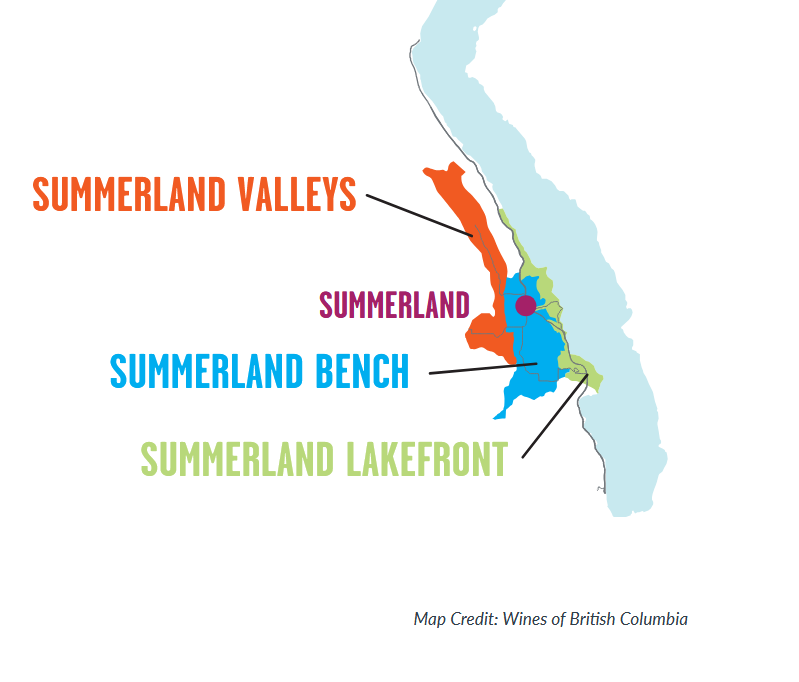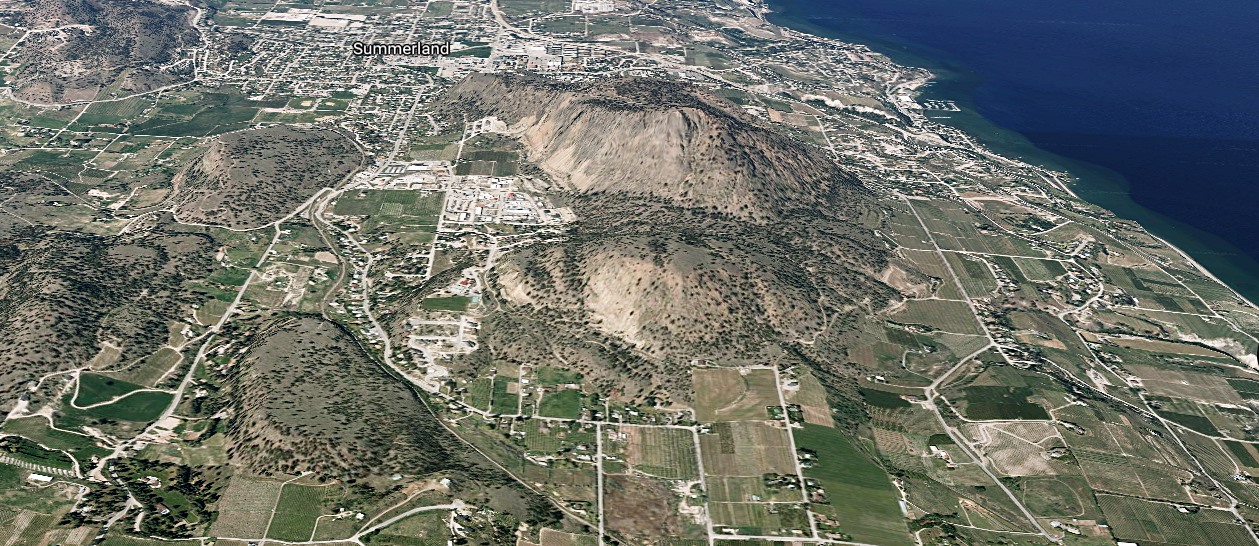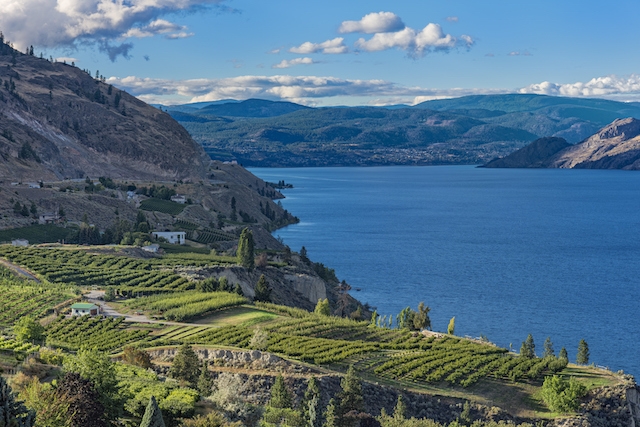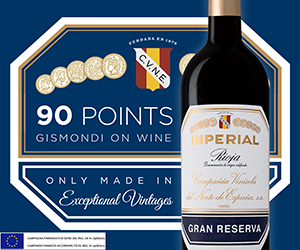The community of Summerland is next to Highway 97 on the Eastern side of Lake Okanagan, directly across from the town of Naramata and its adjacent necklace of wineries.
In 2019, the Bottleneck Drive Association, a collection of wineries, cideries, distilleries, and breweries in the Summerland area, led the application to delineate several new sub-GIs. Three contiguous sub-GIs, Summerland Lakefront, Summerland Bench and Summerland Valleys, were granted, though several more were initially sought.
It broke new ground because this was the first time multiple sub-GIs were created across a site unofficially referred to as a single sub-region, namely Summerland. This was partly due to the complex geology and resulting soil types in the area and proximity to the lake's moderating influence, narrow shielded valleys, microclimates and other factors. Adding these three sub-GIs in 2022, along with three others - East Kelowna Slopes, Lake Country, and South Kelowna Slopes; brought the total number of sub-GIs in the Okanagan Valley to eleven.
proximity to the lake's moderating influence, narrow shielded valleys, microclimates and other factors. Adding these three sub-GIs in 2022, along with three others - East Kelowna Slopes, Lake Country, and South Kelowna Slopes; brought the total number of sub-GIs in the Okanagan Valley to eleven.
Summerland's location in the Central Okanagan, north of Okanagan Falls, south of Kelowna and Lake Country and proximal to Lake Okanagan Lake puts it well in pinot noir's comfort zone. Quality pinot noir is currently being made in all three sub-GIs.
Over the next month, we'll be taking a closer look at the wineries in all three sub-gi's every two weeks, beginning with Summerland Lakefront.
OVERVIEW
The town of Summerland sits in the crater of an exploded volcano that sent enormous lava chunks South and West, including what is now Giant's Head Mountain. In the last several million years,
 glaciers ran over these lava chunks and volcanic domes in the area, scouting and sculpting them into the rounded summits now arrayed around Summerland.
glaciers ran over these lava chunks and volcanic domes in the area, scouting and sculpting them into the rounded summits now arrayed around Summerland.
When the glaciers retreated, sediment from glacial meltwater buried the terrain below the 500 m elevation about ten thousand years ago, leaving most of the valley bottom filled with gravel.
Sub-GI Determinations and Differences
Many factors influenced how and why the three sub-GIs were created in such proximity in Summerland, in contrast to all of the previous B.C. sub-GIs in clearly separate locations.
Generally, the factors determining the distinctness and boundaries of the three sub-GIs include elevation, aspect (including proximity to the lake's moderating effect), and topography. Variations in soils were also instrumental in the sub-GI process. These variations included soil type, structure, texture (sandy or coarse), and geological origin.
The three sub-GIs step progressively back and up from Lake Okanagan, with overlapping East/West boundaries and distinct altitude variations. Few wineries are in the central part of the district. They are mostly grouped north of the Summerland townsite and south of Giant Head Mountain.
Summerland Lakefront sub-GI:
The vineyard areas in Summerland Lakefront, strongly moderated by the lake, are situated in benches that hug Lake Okanagan. The soils are silty and often carbonate (lime) rich. Its eastern boundary is 12 kilometres of the shoreline of Lake Okanagan. The sub-GI is 760 hectares, with about 65 hectares planted to vines. The sub-GI has an annual average of 1347 growing degree days. Pinot noir represents about 25% of the vineyard plantings.
Two distinct soil types are present here. The first, with a total area of 550 ha, is an ancient glacier lake bottom with mostly finer-grained carbonate soils. These soils are virtually identical to some found directly across the lake on the Naramata bench, formed simultaneously. The Summerland area marks the northernmost extent of the Osoyoos loamy sand, the dominant soil type along the Black Sage Bench in the southern Okanagan Valley.
The second soil type, possessing more gravelly subsoils, is found in the delta at the mouth of Trout Creek in the southern part of the sub-GI, just above lake level, and has a total area of 255 ha. Most of the vineyards in this part of the sub-GI have gentle East or South-Easterly aspects and benefit from the moderating effects of Lake Okanagan. They have excellent air drainage and a long frost-free period, allowing for an extended fruit maturation period in most years.
The area's variety of soils is due to the varying seasonal water flows from Trout Creek. Currently, the mainstem of Trout Creek is mainly on the Southern edge of the delta, but previously, the creek channel meandered across the entire width of the delta. During periods of highest flows, coarse material (gravel and cobbles) is deposited along the main channel(s), while the smaller stream network deposits finer materials (silts and sands) through overbank flooding. These deposits generate a wide range of soil conditions on the delta.
The wineries located in Summerland Lakefront sub-GI include 8th Generation Vineyard, Haywire Winery, Sage Hills Estate Winery and Vineyards, Heaven's Gate Estate Winery, Summerland Estate Winery, Evolve Cellars, Oak Estate Winery and Savard Vines (now permanently closed).
Here are the three most noteworthy pinot noir-producing wineries in this sub-GI:
8th Generation
The acclaim that 8th Generation Vineyard has received over the years for its white wines, principally their rieslings, might explain why their silky, elegantly balanced, distinctive, gold medal-winning pinot noir is often overlooked and underappreciated. A husband-and-wife team, Bernd Schales is an 8th-generation winemaker, and Stefanie Schales is a 10th-generation winegrower. Bernd had an essential role in his family winery in Germany, but the couple wanted to do something independently. After searching various vineyard areas in South America and Niagara, Ontario, they settled on the Okanagan Valley, buying properties in Okanagan Falls and Summerland, where 8th Generation is now based. Their first vintage was in 2007. They quickly established a reputation for quality, consistency and innovation. The estate pinot noir from the home vineyard is made from clone 667 and has a particular set of flavours that tend to set it apart from other B.C. pinots. It may be due to the vineyard's unique placement in the Trout Creek delta. It is typically fuller, with savoury fruit, more complex, textured tannins and a hint of minerality in the finish. It ages very well.
Haywire Winery/Okanagan Crush Pad
Previously known as Okanagan Crush Pad, the winery has recently rebranded and is now known as Haywire Winery. Their properties also include Garnet Valley Ranch in the Summerland Valleys sub-GI. Okanagan Crush Pad had previously focused in part on doing custom crush work for various smaller B.C. wineries that lacked winemaking facilities. Many wineries got their start at Okanagan Crush Pad. It was founded by Christine Coletta and Steve Lornie in 2005 with a 10-acre orchard growing apples and apricots. The planting of vineyards subsequently replaced the fruit trees. The first small vintage of 165 cases was in 2009. Their focus moved progressively towards less interventionist farming, and now all the vineyards are organic. Their senior winemaker, Matt Dumayne, joined them in 2013. Their pinot noir bottlings, over time, have included grapes sourced from their vineyards and those of selected growers, including Canyonview Vineyard and Waters & Banks.
Sage Hills
Sage Hills Estate Winery is a 100% organic winery that produces only natural, organic wines with a philosophy of nothing added and nothing removed. The wines are low-yield, single-vineyard, and 100% vegan. In their ongoing effort towards sustainability, they run entirely off solar energy in their cellar and tasting room. They are the first small net-zero wineries in the Okanagan Valley region. Founded and operated by Rick Thrussell and his wife Toby, since 2017, their son Keenan has been making the wine along with his partner Zoë Jacoe, who manages the vineyard and winery. From 2019 onward, winemaking has shifted from the more conventional to natural wines. This includes wild ferments, 100% whole berry fermentation, ageing on lees for seven months, neutral barrels, no added sulphites, and minimal intervention. They recommend drinking the entire bottle once opened. The first pinot noir vintage was made in 2012 by Tom DiBello at Okanagan Crush Pad.

 quicksearch
quicksearch






